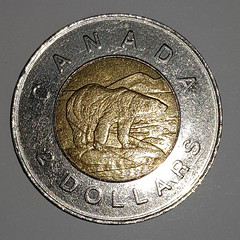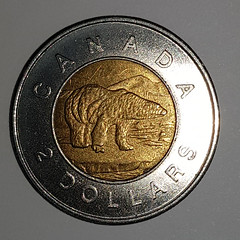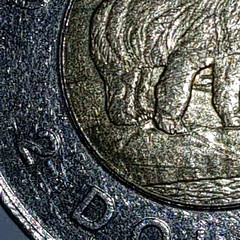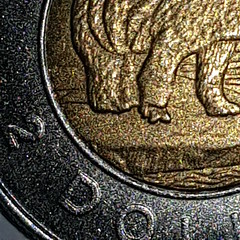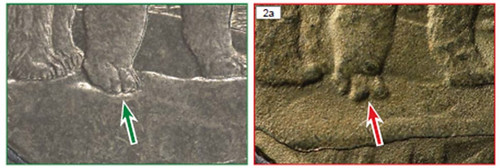
PREV ARTICLE
NEXT ARTICLE
FULL ISSUE
PREV FULL ISSUE
COUNTERFEIT CANADIAN 'CAMEL TOE' TOONIESAllan Behul submitted this article on the counterfeit Canadian two-dollar coin, also known as the "camel toe toonie". Thank you. -Editor
Counterfeit Coins in Canada: The Story of the
Camel Toe Toonie A.J. Behul
If you stopped an average Canadian on the street, and asked about counterfeiting in Canada,
(s)he would probably think of $50 or $100 dollar bills; the thought of the
Specifically, the
According to Brent W.J. Mackie, Treasurer of the Waterloo Coin Society, and dedicated
researcher of the Counterfeit coins have been found dated: 1996, 2002, 2004, 2005, 2006, 2007, and 2010.
Identifiable characteristics of the
Others include the omission of the initials
It is interesting to note, that the number of
At this point, we may find ourselves asking, Actually, significant. Mackie (conservatively) estimates that there could be five million counterfeit toonies in circulation, but the actual number is probably much higher; taking into consideration an overall saturation rate of 0.5% against a cumulative mintage of genuine toonies issued by the RCM (Royal Canadian Mint). The genuine coin on the left versus the counterfeit on the right. Genuine: Fine details of the bear's paws. 2a: The polar bear's paw is misshapen.
In a press release dated May 9, 2022, the RCMP (Royal Canadian Mounted Police) stated
that approximately 10,000 counterfeit toonies were identified and seized, following an
investigation conducted by the GTA-TSOC (Greater Toronto Area Trans-National Serious
& Organized Crime) Section, which resulted in charges being laid against a Richmond Hill,
Ontario resident, including
The RCMP also commented that
Perhaps a subsequent question that we may have would be, Apparently so.
If the cited volume of counterfeit
It is quite likely that we will have to wait for some time, to see where this story ends, who
the criminal author(s) were, and what methods were used to introduce the
In the meantime, the next time you are waiting in line for a coffee or beverage (living in, or
visiting Canada), have a look at the two-dollar coin that may be lying innocuously in
between your pocket change; you may just find the now infamous P.S. If you do chance upon a counterfeit toonie, or believe someone has attempted to pass along counterfeit currency to you, as indicated by the RCMP, it should be reported to the local police, the Ontario RCMP, or anonymously through Crime Stoppers.
To read the RCMP press release, see:
Wayne Homren, Editor The Numismatic Bibliomania Society is a non-profit organization promoting numismatic literature. See our web site at coinbooks.org. To submit items for publication in The E-Sylum, write to the Editor at this address: whomren@gmail.com To subscribe go to: https://my.binhost.com/lists/listinfo/esylum All Rights Reserved. NBS Home Page Contact the NBS webmaster 
|
